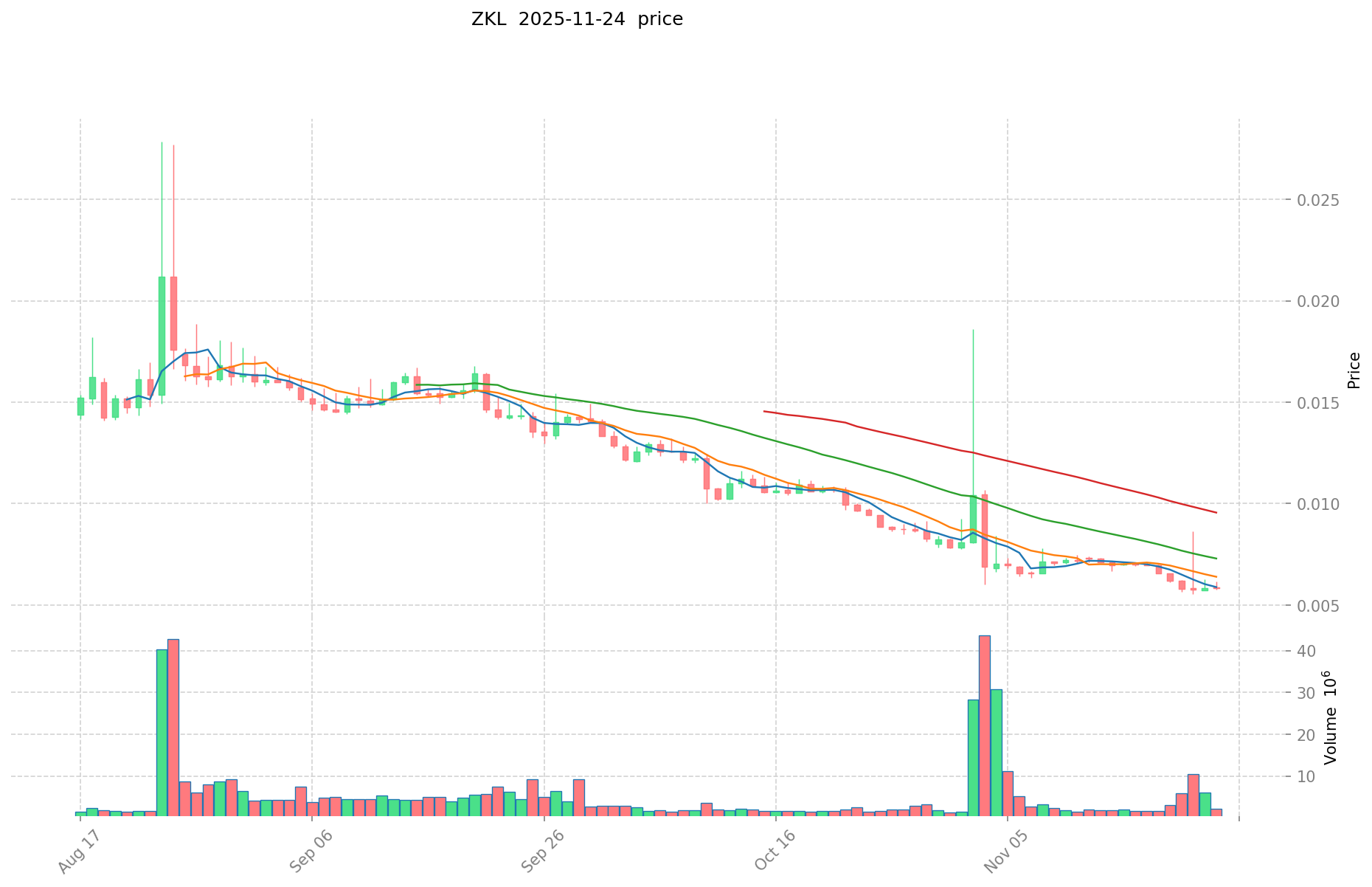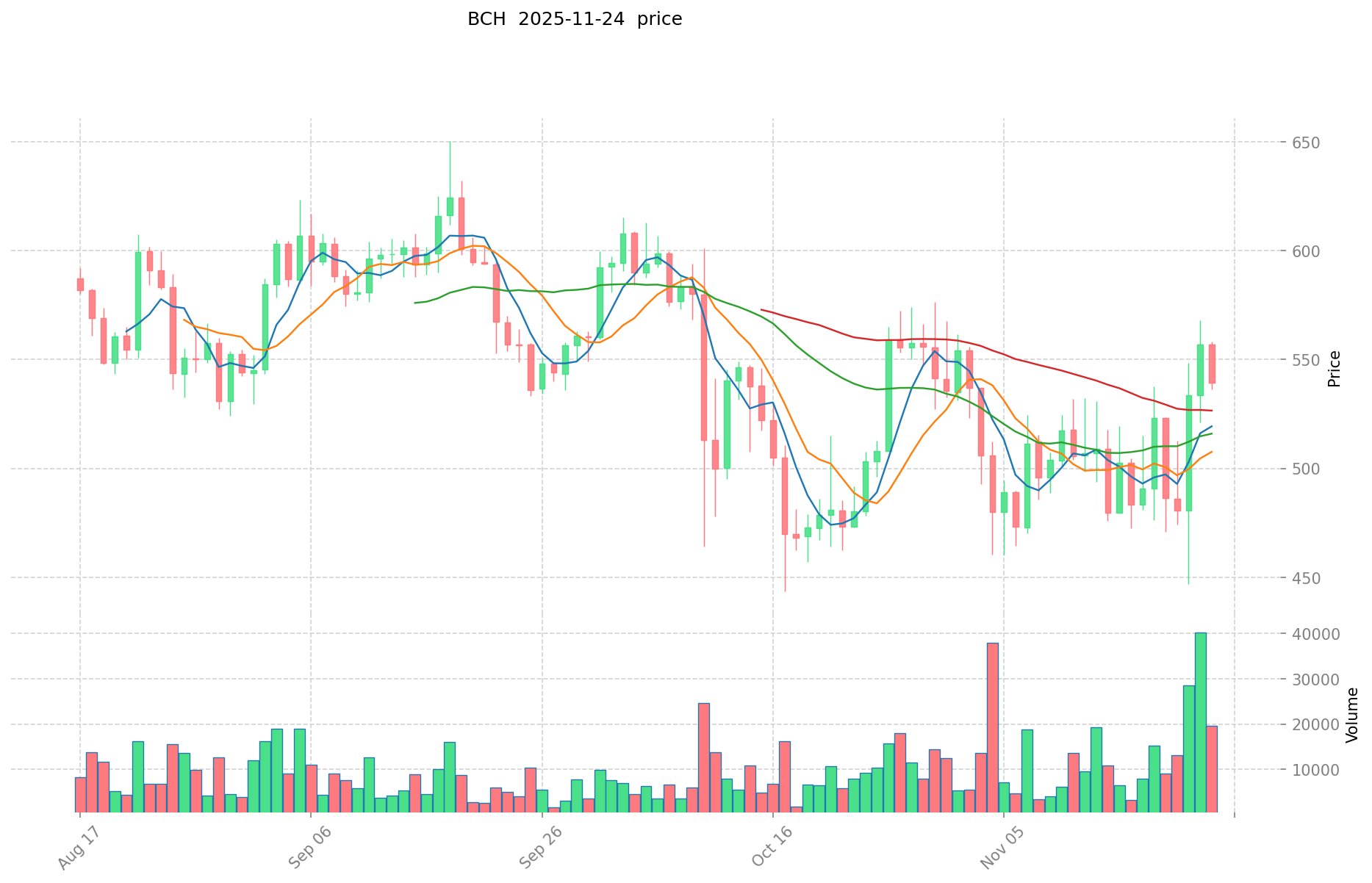ZKL vs BCH: Comparing the Blockchain Innovations and Market Impact
Introduction: ZKL vs BCH Investment Comparison
In the cryptocurrency market, the comparison between zkLink (ZKL) and Bitcoin Cash (BCH) remains an unavoidable topic for investors. The two not only differ significantly in market cap ranking, application scenarios, and price performance but also represent different positioning in the crypto asset space.
zkLink (ZKL): Launched in 2024, it has gained market recognition for its multi-chain aggregation and liquidity solutions.
Bitcoin Cash (BCH): Since its inception in 2017, it has been hailed as a "peer-to-peer electronic cash system," and is one of the cryptocurrencies with high global trading volume and market capitalization.
This article will comprehensively analyze the investment value comparison between ZKL and BCH, focusing on historical price trends, supply mechanisms, institutional adoption, technological ecosystems, and future predictions, attempting to answer the question investors care about most:
"Which is the better buy right now?"
I. Price History Comparison and Current Market Status
ZKL (Coin A) and BCH (Coin B) Historical Price Trends
- 2024: ZKL reached its all-time high of $0.76698 on July 22, 2024.
- 2017: BCH was created through a hard fork of Bitcoin on August 1, 2017, with an initial price of $555.89.
- Comparative analysis: ZKL has experienced a significant decline from its all-time high, currently trading at $0.005851, while BCH has shown more stability, trading at $546.46, close to its initial launch price.
Current Market Situation (2025-11-24)
- ZKL current price: $0.005851
- BCH current price: $546.46
- 24-hour trading volume: ZKL $12,135.06 vs BCH $10,537,093.10
- Market Sentiment Index (Fear & Greed Index): 19 (Extreme Fear)
Click to view real-time prices:
- View ZKL current price Market Price
- View BCH current price Market Price
II. Project Overview and Technological Comparison
ZKL (zkLink)
zkLink is a multi-chain aggregation ZK-Rollup infrastructure that aims to solve the problem of liquidity fragmentation between different blockchain networks. It offers two core solutions:
- zkLink Nova: A general-purpose Ethereum Layer 3 network that integrates assets, liquidity, and dApps from Ethereum Layer 2 into a single, secure, and efficient EVM-compatible platform.
- zkLink X: A Rollup middleware for customized dApps, serving high-performance dApp multi-chain deployment and liquidity aggregation.
BCH (Bitcoin Cash)
Bitcoin Cash is a cryptocurrency that originated from a hard fork of Bitcoin in 2017. Its key features include:
- On-chain scaling with 8MB blocks
- Enhanced transaction signatures
- New difficulty adjustment algorithm
- Decentralized development
BCH aims to follow Satoshi Nakamoto's vision for global adoption and scalability.
Technological Comparison
- Scaling approach: ZKL focuses on Layer 2 and Layer 3 scaling solutions using zero-knowledge technology, while BCH emphasizes on-chain scaling through larger block sizes.
- Interoperability: ZKL is designed for multi-chain aggregation and cross-chain liquidity, whereas BCH primarily operates on its own blockchain.
- Smart contract capabilities: ZKL supports EVM compatibility, enabling complex smart contract functionalities, while BCH has more limited smart contract capabilities.
III. Market Performance Analysis
Market Capitalization and Ranking
- ZKL: Market cap of $2,462,040, ranked #2020
- BCH: Market cap of $10,905,905,378, ranked #13
Price Change Percentages
ZKL:
- 1H: +0.13%
- 24H: -0.06%
- 7D: -16.55%
- 30D: -38.080%
- 1Y: -94.58%
BCH:
- 1H: +1.21%
- 24H: -1.12%
- 7D: +11.84%
- 30D: +8.72%
- 1Y: +7.10%
Trading Volume and Liquidity
- ZKL 24H trading volume: $12,135.06
- BCH 24H trading volume: $10,537,093.10
BCH demonstrates significantly higher liquidity and trading activity compared to ZKL.
IV. Investment Considerations
-
Market maturity: BCH, as a more established project, may offer greater stability but potentially lower growth potential. ZKL, being newer, could present higher risk but also higher potential returns.
-
Technology adoption: Consider the long-term viability and adoption potential of ZK-Rollup technology (ZKL) versus on-chain scaling (BCH).
-
Network effect: BCH benefits from greater recognition and a larger user base, while ZKL is still building its ecosystem.
-
Market trends: Evaluate the growing interest in Layer 2 and cross-chain solutions, which could benefit ZKL, against the established position of BCH in the cryptocurrency market.
-
Risk assessment: ZKL's recent price performance indicates higher volatility and potential risk, while BCH has shown more stable performance over the past year.
V. Conclusion
Both ZKL and BCH represent different approaches to blockchain scaling and adoption. ZKL focuses on advanced Layer 2 and Layer 3 solutions with cross-chain capabilities, while BCH emphasizes on-chain scaling and adherence to Bitcoin's original vision. Investors should carefully consider their risk tolerance, investment horizon, and belief in the long-term potential of each project's technological approach when making investment decisions.


II. Core Factors Affecting ZKL vs BCH Investment Value
Supply Mechanism Comparison (Tokenomics)
- BCH: Follows a halving mechanism similar to Bitcoin, with a maximum supply of 21 million coins
- 📌 Historical pattern: Supply mechanisms with fixed caps and halving events tend to create cyclical price movements due to reduced inflation over time.
Institutional Adoption and Market Applications
- Institutional holdings: Limited institutional interest in both assets compared to mainstream cryptocurrencies
- Enterprise adoption: BCH has been integrated into some payment systems for faster and cheaper transactions
- National policies: Regulatory approaches vary by country, with most jurisdictions treating both as standard cryptocurrencies
Technical Development and Ecosystem Building
- BCH technical development: Focuses on scaling improvements for payment functionality, larger block sizes, and maintaining the original vision of peer-to-peer electronic cash
- Ecosystem comparison: BCH has more established payment infrastructure and merchant adoption, while both have limited DeFi and NFT ecosystems compared to leading blockchains
Macroeconomic Factors and Market Cycles
- Performance in inflationary environments: BCH has historically been positioned as digital gold/inflation hedge due to its fixed supply cap
- Macroeconomic monetary policy: Both assets tend to show correlation with broader crypto market movements in response to interest rates and dollar strength
- Geopolitical factors: Cross-border transaction demand can potentially benefit both currencies during periods of financial instability
III. 2025-2030 Price Prediction: ZKL vs BCH
Short-term Prediction (2025)
- ZKL: Conservative $0.00404 - $0.00585 | Optimistic $0.00585 - $0.00638
- BCH: Conservative $469.30 - $545.70 | Optimistic $545.70 - $594.81
Mid-term Prediction (2027)
- ZKL may enter a growth phase, estimated price range $0.00658 - $0.00808
- BCH may enter a volatile phase, estimated price range $359.26 - $856.24
- Key drivers: Institutional fund inflows, ETF, ecosystem development
Long-term Prediction (2030)
- ZKL: Base scenario $0.00695 - $0.00966 | Optimistic scenario $0.00966 - $0.01342
- BCH: Base scenario $438.74 - $797.71 | Optimistic scenario $797.71 - $1084.88
Disclaimer: The above predictions are based on historical data and market analysis. Cryptocurrency markets are highly volatile and subject to rapid changes. This information should not be considered as financial advice. Always conduct your own research before making investment decisions.
ZKL:
| 年份 | 预测最高价 | 预测平均价格 | 预测最低价 | 涨跌幅 |
|---|---|---|---|---|
| 2025 | 0.00637759 | 0.005851 | 0.00403719 | 0 |
| 2026 | 0.0074594399 | 0.006114295 | 0.00470800715 | 4 |
| 2027 | 0.0080763722655 | 0.00678686745 | 0.0065832614265 | 15 |
| 2028 | 0.009438157219342 | 0.00743161985775 | 0.003938758524607 | 27 |
| 2029 | 0.010881006214724 | 0.008434888538546 | 0.007338353028535 | 44 |
| 2030 | 0.013424546853523 | 0.009657947376635 | 0.006953722111177 | 65 |
BCH:
| 年份 | 预测最高价 | 预测平均价格 | 预测最低价 | 涨跌幅 |
|---|---|---|---|---|
| 2025 | 594.813 | 545.7 | 469.302 | 0 |
| 2026 | 627.28215 | 570.2565 | 524.63598 | 4 |
| 2027 | 856.24013475 | 598.769325 | 359.261595 | 9 |
| 2028 | 756.60491907 | 727.504729875 | 487.42816901625 | 33 |
| 2029 | 853.363048143375 | 742.0548244725 | 615.905504312175 | 35 |
| 2030 | 1084.884153378795 | 797.7089363079375 | 438.739914969365625 | 45 |
IV. Investment Strategy Comparison: ZKL vs BCH
Long-term vs Short-term Investment Strategies
- ZKL: Suitable for investors focused on Layer 2/3 solutions and cross-chain potential
- BCH: Suitable for investors seeking established networks and payment use cases
Risk Management and Asset Allocation
- Conservative investors: ZKL: 5% vs BCH: 15%
- Aggressive investors: ZKL: 15% vs BCH: 25%
- Hedging tools: Stablecoin allocation, options, cross-currency portfolios
V. Potential Risk Comparison
Market Risk
- ZKL: High volatility, low liquidity, potential for significant price swings
- BCH: Moderate volatility, higher liquidity, subject to overall crypto market trends
Technical Risk
- ZKL: Scalability, network stability, adoption of ZK-Rollup technology
- BCH: Mining centralization, security vulnerabilities
Regulatory Risk
- Global regulatory policies may impact both assets differently, with BCH potentially facing more scrutiny due to its wider recognition and use as a payment system
VI. Conclusion: Which Is the Better Buy?
📌 Investment Value Summary:
- ZKL advantages: Innovative Layer 2/3 technology, cross-chain capabilities, growth potential
- BCH advantages: Established network, higher liquidity, recognized brand in crypto payments
✅ Investment Advice:
- Novice investors: Consider a small allocation to BCH for exposure to established crypto assets
- Experienced investors: Balanced approach with both ZKL and BCH, adjusting based on risk tolerance
- Institutional investors: Focus on BCH for liquidity and market recognition, monitor ZKL for future potential
⚠️ Risk Warning: Cryptocurrency markets are highly volatile. This article does not constitute investment advice. None
VII. FAQ
Q1: What are the main differences between ZKL and BCH? A: ZKL focuses on Layer 2/3 scaling solutions and cross-chain interoperability, while BCH emphasizes on-chain scaling and peer-to-peer electronic cash functionality. ZKL is newer with potential for growth, while BCH is more established with higher liquidity and market recognition.
Q2: Which coin has performed better in terms of price in the past year? A: Based on the data provided, BCH has performed better in the past year with a +7.10% price change, while ZKL has experienced a significant decline of -94.58% over the same period.
Q3: How do the market capitalizations of ZKL and BCH compare? A: There is a substantial difference in market capitalization. BCH has a market cap of $10,905,905,378 and is ranked #13, while ZKL has a market cap of $2,462,040 and is ranked #2020.
Q4: What are the key technological features of each coin? A: ZKL offers multi-chain aggregation and ZK-Rollup infrastructure, focusing on solving liquidity fragmentation between blockchain networks. BCH features larger block sizes for on-chain scaling, enhanced transaction signatures, and aims to be a global peer-to-peer electronic cash system.
Q5: How do the supply mechanisms of ZKL and BCH differ? A: BCH follows a halving mechanism similar to Bitcoin with a maximum supply of 21 million coins. The supply mechanism for ZKL is not explicitly stated in the provided information.
Q6: Which coin might be better suited for different types of investors? A: Conservative investors might prefer BCH due to its established network and higher liquidity. Aggressive investors looking for higher growth potential might consider ZKL for its innovative technology in Layer 2/3 solutions. The specific allocation depends on individual risk tolerance and investment goals.
Q7: What are the main risks associated with investing in ZKL and BCH? A: ZKL carries higher market risk due to its volatility and low liquidity, as well as technical risks related to the adoption of its technology. BCH faces moderate market volatility and potential regulatory scrutiny due to its wider recognition as a payment system. Both are subject to overall cryptocurrency market trends and regulatory risks.
Share
Content